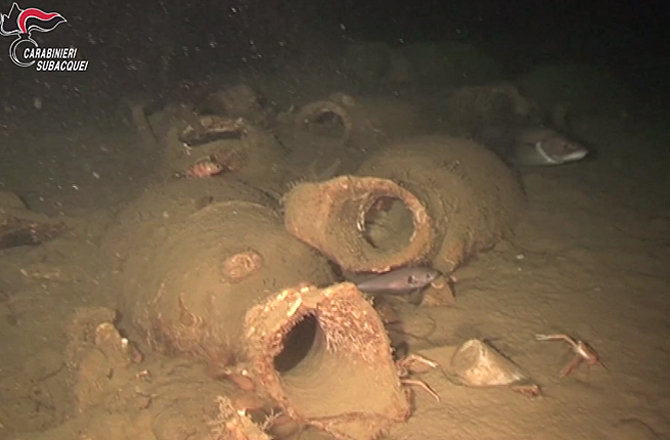
Considered a delicacy, the smelly liquid was mass produced in factories, especially in Spain and Portugal.
Resting at a depth of more than 650 feet in the waters off the Ligurian coast near Alassio, the vessel is estimated to be 98 feet long and dates between the first and the second century A.D.
The jars are now piled up on the seafloor. Ironically, they are a shelter to fish.
"From the size of the jar-made mound we estimate the ship was carrying between 2,000 and 3,000 amphoras, or clay jars," team leader Simon Luca Trigona, coordinator of the technical services of underwater archaeology at the archaeological superintendency of Liguria, told Discovery News.
Trigona's team worked with the Carabinieri scuba diver police force to localize the wreck, whose existence was signaled two years ago by a local fisherman.
Once the wreck site was identified, the team used a remote operated vehicle (ROV) with a claw to retrieve one of the jars.
"It has not been possible yet to recover a jar with residues that can be analyzed. However, the one we brought to light, which is identical to all the others, is of a shape that was used exclusively for garum," Vincenzo Tiné, Superintendent of Archaeology of Liguria, told Discovery News.
Made from fermenting fish in saltwater, garum was basically the ketchup of the ancient Romans. It featured a much appreciated sweet and sour taste, and was used in almost on every dish, often substituting expensive salt.
The vessel had probably left the port of Cadiz in Spain, which at the time was an important center for the fish sauce industry, and was sailing along the coast headed to Rome.
Indeed, a couple of wine jars likely used by the crew and produced in the area around the river Tiber, point to Rome as the vessel's port of provenance.
According to Trigona, the cargo ship shows for the first time that the Romans did not only follow the traditional direct route from southern Spain, off the Balearic islands and Corsica to Rome.
"They also sailed along the coast, possibly during difficult weather," Trigona said.
The nearly 2,000 year old wreck is one of just five deep sea Roman ships found in the Mediterranean.
"Locating and investigating it at such depth has been a very important achievement," Tiné said.



Reader Comments
to our Newsletter